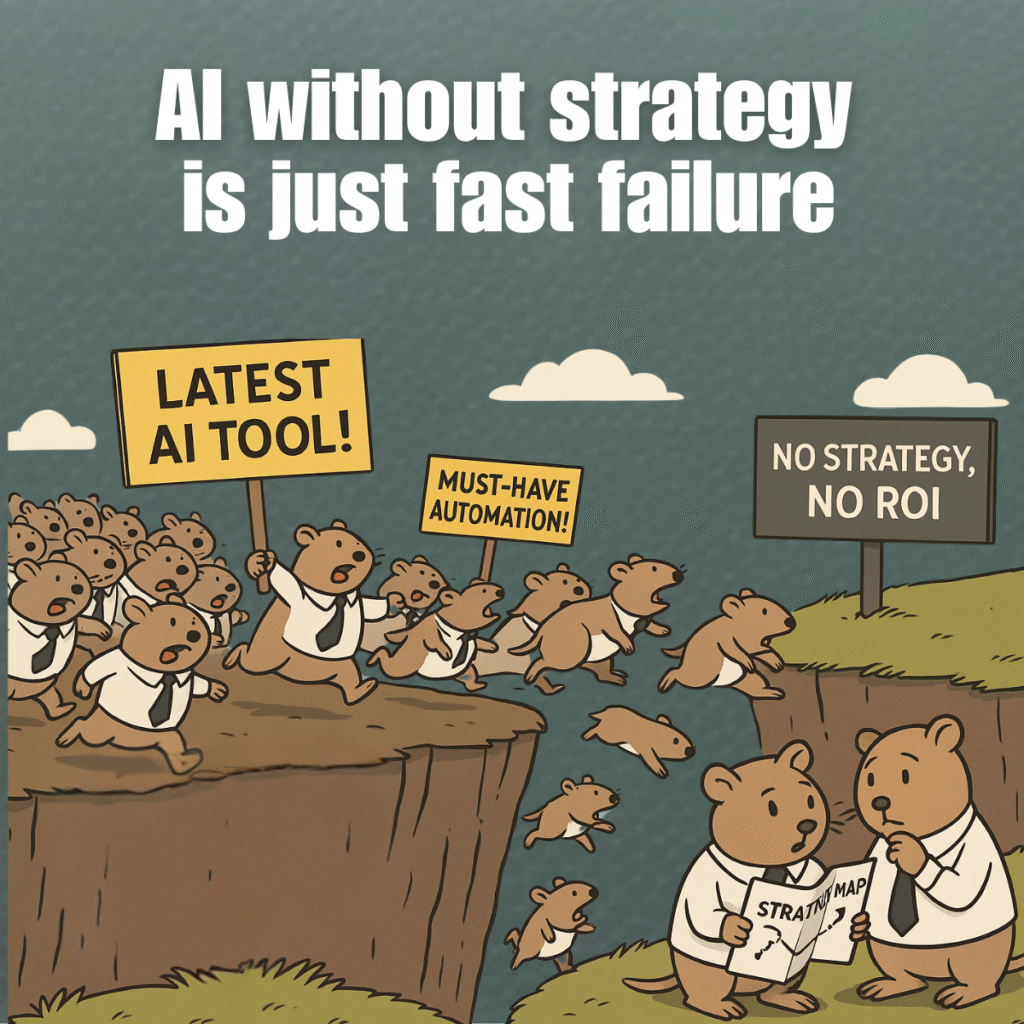AI is everywhere. From content generation to predictive analytics, there’s no shortage of tools promising to revolutionise how marketing teams work. The pressure to “get on board” is intense—whether from leadership, peers, or the market at large.
But before you take the plunge, it’s worth pausing. Not to avoid action, but to avoid waste.
AI is not a silver bullet. It can be transformative—but only when it solves a real business problem, integrates into your workflow, and delivers a clear return.
This guide is designed to help you step back and evaluate where AI can truly make a difference in your marketing operation. It’s not about chasing the latest trend. It’s about making smart, strategic decisions that align with your business goals.
Step 1: Define the Real Problems Worth Solving
Start with problems, not products.
Too many companies adopt AI without a clear reason, ending up with tools that sit unused or fail to deliver. The first step is a practical audit of your marketing operation. Ask:
-
Where are the bottlenecks or delays?
-
Which tasks are repetitive and time-consuming?
-
Are there any blind spots in data, performance, or customer insight?
-
Where does your team struggle to keep up with scale or complexity?
Look for tasks that are high-frequency, low-value—things that take up time but don’t require human creativity or deep judgement. These are your best candidates for automation.
Also consider high-value tasks where AI could add strategic leverage, such as predictive lead scoring or performance forecasting.
Pitfall to avoid: Adopting AI to solve a problem that doesn’t exist—or one that could be more easily fixed with better processes or people.
Step 2: Quantify the Upside
Not every problem is worth automating. Once you’ve identified opportunities, you need to assess whether the potential benefit stacks up.
AI tools should deliver tangible outcomes in one or more of the following areas:
-
Time saved (hours per week/month)
-
Cost reduced (fewer manual resources or errors)
-
Revenue unlocked (better targeting, personalisation, conversion)
-
Decision speed or quality improved (faster insights, reduced guesswork)
Build a simple model. Estimate the hours saved, the cost per hour of your team, or the potential revenue lift from improved targeting or segmentation.
If the upside is unclear or marginal, the tool may not be worth the investment—especially given the cost of implementation and training.
Pitfall to avoid: Choosing tools that only offer small gains in niche areas, while consuming disproportionate time or attention.
Step 3: Test Compatibility With Your Ecosystem
AI tools don’t exist in a vacuum. They need to integrate with your existing systems—CRM, CMS, email platform, ad tools, analytics—and fit into your team’s workflow.
Before selecting a tool, consider:
-
Does it have native or API integrations with our key platforms?
-
Will it require developer time to set up or maintain?
-
How easy is it for non-technical users to adopt and use?
-
Is the data it uses reliable, structured, and accessible?
-
Does it create duplication or overlap with existing tools?
Don’t underestimate the friction caused by tools that don’t connect easily. Fragmented workflows lead to poor adoption, duplicated effort, and loss of trust in the system.
Pitfall to avoid: Buying a powerful AI tool that doesn’t “talk” to your stack—or worse, creates more work to maintain than it saves.
Step 4: Align Tool Use With Strategy, Not Just Tactics
Every tool you adopt should support a broader strategic goal—not just plug a tactical gap.
Ask yourself:
-
What strategic outcome will this tool help us achieve?
-
How will it change how we work or deliver value to customers?
-
Will this create a competitive advantage—or just keep us level?
It’s easy to get excited about tools that do clever things. But unless they move you closer to a core business objective, they’re just noise.
Build workflows around outcomes, not features. For example:
-
If your goal is to reduce time to campaign launch, AI can streamline planning, briefing, and creative.
-
If your goal is to improve lead quality, AI can help with predictive scoring, persona segmentation, and real-time optimisation.
Pitfall to avoid: Falling into tool-led thinking—trying to retrofit your strategy around whatever the software can do, rather than choosing software that fits your strategy.
Step 5: Define Success Before You Start
Success shouldn’t be something you define retroactively. Before implementing any AI tool, agree on what success looks like.
That includes:
-
Baseline metrics: Where are you now?
-
Success metrics: What will the tool improve?
-
Measurement plan: How and when will you measure results?
-
Accountability: Who owns the tool’s success?
Avoid measuring success purely in usage terms. Focus instead on how the tool affects performance, revenue, or productivity.
High-value metrics might include:
-
Time saved on reporting or analysis
-
Reduction in campaign turnaround time
-
Uplift in customer engagement or conversion
-
Increased forecasting accuracy or attribution clarity
Pitfall to avoid: Measuring usage instead of impact. Just because a team uses a tool doesn’t mean it’s valuable.
Other Common Pitfalls to Avoid
-
“We’ll figure it out later” thinking — tools need a clear onboarding and implementation plan or they’ll get abandoned.
-
Tool overload — more tools lead to more complexity. Focus on a streamlined, integrated stack.
-
Ignoring team readiness — tools won’t deliver if your team isn’t trained, bought in, or equipped to use them.
-
Lack of ownership — every tool needs a champion to ensure adoption, performance, and ROI.
-
Buying for features, not outcomes — demo environments can be misleading. Always test against real-world use cases.
-
Underestimating change management — AI adoption requires behaviour change, communication, and support.
Final Checklist: Is This Tool Worth It?
Before moving forward, ask:
-
Does this solve a real, high-impact problem?
-
Will it save time, improve outcomes, or reduce cost?
-
Does it integrate cleanly into our existing systems?
-
Can we measure ROI within six months?
-
Is there a clear owner and plan for adoption?
If the answer isn’t a confident “yes” to most of these, it’s worth revisiting your priorities.
Not Sure Where to Start?
If you’re still unsure where AI can deliver the biggest impact in your 2025 / 2026 marketing roadmap, consider an AI x Growth Audit.
In one page, you’ll get:
-
A review of your current marketing tech stack and pain points
-
A clear view of the best automation and optimisation opportunities
-
Smart, tailored AI tool recommendations based on your business needs



